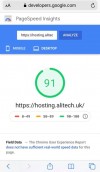What Are Google’s Verified Checkmarks?
Google’s verified checkmarks are small blue icons that appear next to certain businesses in search results. Much like the familiar verification badges we see on social media platforms, these checkmarks indicate that a business has been verified by Google. This verification process is designed to ensure that the business being represented in the search result is genuine and not an impostor.
Purpose Behind Introducing Verified Checkmarks
The internet can be a tricky place, full of fake websites and scammy businesses. Google's goal with the checkmark system is to make it easier for users to distinguish real businesses from fraudulent ones. By introducing this feature, Google aims to reduce the risk of users unknowingly clicking on harmful or deceptive links, protecting both businesses and consumers alike.
How Verified Checkmarks Differ from Existing Security Features
You might be wondering, "How is this different from existing security features like HTTPS?" Well, while HTTPS ensures that your connection to a website is secure, it doesn't necessarily verify the legitimacy of the business behind the site. That’s where these checkmarks come in. This feature, which builds on the Brand Indicators for Message Identification (BIMI) system Google already uses in Gmail, goes a step further by verifying the actual identity of the business in question.
Early Observations of Verified Checkmarks
While Google hasn’t fully rolled out this feature yet, some users have already noticed checkmarks next to high-profile businesses like Microsoft, Apple, and Meta. Interestingly, these checkmarks seem to disappear when users log in with different Google accounts, indicating that the feature is still in its experimental phase.
How Does Google Determine Verification?
According to Google, verification is based on several "signals" that indicate a business’s legitimacy. These signals include website verification, data from Google’s Merchant Center, and even manual reviews by Google staff. If a business checks all the right boxes, it gets the blue tick of approval in search results.
Impact on Businesses and Users
For businesses, this verification could be a big deal. It adds an extra layer of credibility, which can be particularly important in competitive industries. For users, these checkmarks offer a sense of security, knowing that the link they’re about to click is legitimate and not a phishing attempt. This builds trust between businesses and consumers, creating a safer browsing experience for everyone.
Limited Rollout of the Feature
Currently, only a small number of users and businesses are seeing the checkmarks in their search results. This limited rollout suggests that Google is still testing the waters before a full-scale release. The feedback from this trial period will likely determine whether or not the feature becomes a permanent addition to Google Search.
Potential Expansion of the Checkmark System
If all goes well, we could see Google expanding this feature to include more businesses and users in the near future. The ultimate goal is to make it easier for everyone to distinguish between legitimate businesses and those that are less trustworthy. This would not only benefit large companies but could also help smaller businesses that meet Google's verification criteria.
Google’s Statement on the Experiment
Google has acknowledged the experiment, with spokesperson Molly Shaheen stating, “We regularly experiment with features that help shoppers identify trustworthy businesses online.” While the company hasn’t made any promises about when — or if — this feature will be rolled out widely, their ongoing tests show they’re taking user safety seriously.
Relation to Gmail’s BIMI Checkmarks
Google’s verified checkmarks in search are actually an extension of the BIMI (Brand Indicators for Message Identification) system that’s been used in Gmail since 2023. In Gmail, these checkmarks help users identify verified email senders, making it harder for phishing attacks to succeed. The success of BIMI in Gmail likely influenced Google’s decision to bring a similar system to search results.
How Users Can Identify Verified Businesses
So how can you tell if a business has been verified? It’s simple: just look for the blue checkmark next to the business name in the search results. If you hover over the checkmark, a pop-up message will appear explaining that “Google’s signals suggest that this business is the business that it says it is.” This quick explanation should give users confidence in the legitimacy of the link.
Concerns and Limitations of the System
Like any system, Google’s verified checkmarks aren’t perfect. One limitation is that Google can’t guarantee the absolute reliability of a business, even if it has a checkmark. The company is careful to emphasize that these checkmarks are based on available signals and data, which means there’s still room for error. Over time, Google may fine-tune the system to make it even more robust.
Future of Verified Checkmarks in Online Safety
Looking ahead, this feature has the potential to be a significant game-changer in online safety. By helping users avoid fraudulent sites and businesses, Google’s verified checkmarks could reduce phishing, scams, and other online threats. In the broader context of cybersecurity, this is a positive step toward making the internet a safer place for everyone.
Conclusion
Google’s verified checkmarks in search are still in their infancy, but they have the potential to make a big impact. By helping users identify trustworthy businesses, this feature could change the way we interact with search results and online businesses. As the feature continues to evolve, it’s likely to become an essential tool for both businesses looking to build trust and users who want to navigate the web safely.
FAQs
What are Google’s verified checkmarks?
Google’s verified checkmarks are blue icons that appear next to certain businesses in search results, indicating that the business is legitimate and verified by Google.
How can businesses get verified?
Businesses can get verified through a process that includes website verification, data from Google’s Merchant Center, and manual reviews by Google.
Will this feature be available to everyone?
Currently, the feature is being tested on a limited number of users and businesses, but it may be rolled out more widely in the future.
How does this differ from other security measures?
Unlike HTTPS, which ensures a secure connection, Google’s checkmarks verify the actual legitimacy of the business behind the website.
Can users fully trust the checkmark system?
While the system adds an extra layer of trust, Google emphasizes that the checkmarks are based on signals and available data, meaning they’re not foolproof.
Source: Google News
Read more blogs: Alitech Blog
TAGS:google, verified checkmarks, search results, online safety, business verification, digital trust, phishing prevention, cybersecurity, Google Search, BIMI, user experience, fraudulent websites, search engine optimization, tech news, business credibility
.png)














